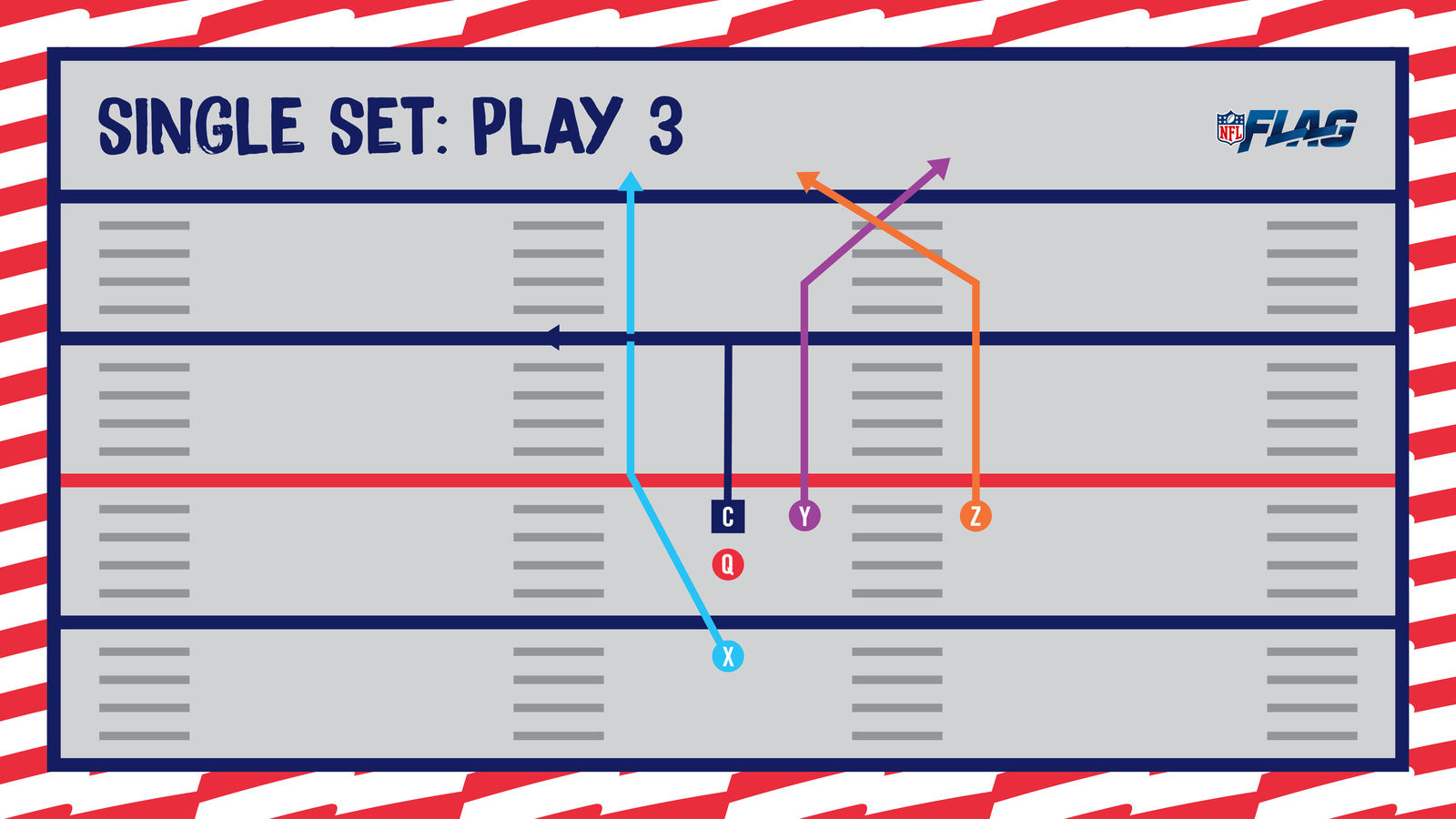5 ON 5 FLAG FOOTBALL PLAYBOOK
Whether you’re a beginner coach preparing for your first season, or the next John Madden, our flag football playbook is perfect for all levels of players.
Quick Links: Single Back | Spread | Bunch | Trips | Twins | I Formation | Double Back Set | Trips Stack | Twins Stack | Single Set
You’ve come up with a team name, researched 5 on 5 flag football rules, and even watched some games online to prepare.
You’re just missing one final key component for the season—the plays! We’ve compiled a thorough list of 5 on 5 flag football plays and formations to equip your team with all the needed information to have a knockout season. Super Bowl, here you come!
Pro-tip: We recommend you read up on the basics of offensive player routes before diving into our flag football playbook. Find a complete guide for offensive routes here.
Single Back Formation
To kick off our football playbook, let’s start with an easier football formation. The single back formation is built with one receiver on either side of the center and quarterback, and one a few yards behind the pair.
Upon hike, the two side receivers —Receiver X and Z —do a post route, cutting toward the center. Meanwhile, Receiver Y does a corner route once they cross the line of scrimmage. If the receivers don’t appear open, the center can then release and do a corner route as well.
Pro-tip: Always decide which receiver is going to move first if their paths are set to cross any youth flag football plays. You don’t want anyone bumping heads!

After the ball is hiked, the Receiver Z does a quick sidestep around the defender, then does a fly route—perfect for long yardage. Receiver Y does a slant and then cuts toward the sideline, occupying the space that should be open from the defender shifting backward to cover the fly route.
Meanwhile, Receiver X and the center do respective post and corner routes to cut off their defenders.
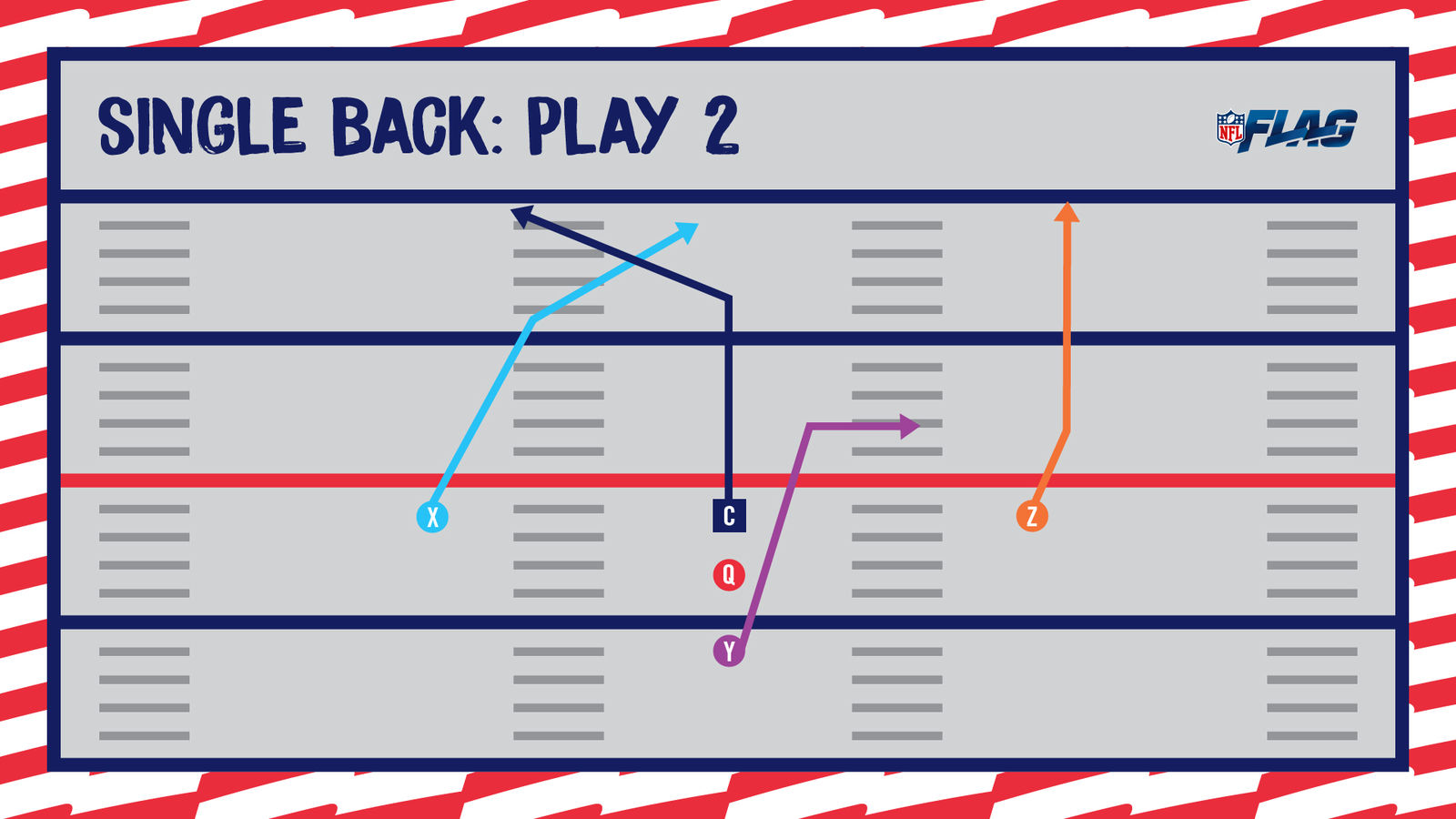
This flag football play is designed to gain short yardage if you’re near the first down line.
The receiver on the right does a 10-yard run, then cuts in at a 90-degree angle. Their assigned defenseman should follow them, leaving the right side of the field open. Then the back receiver can do a dragging slant to occupy that space for an easy catch.
The other side receiver and center do crossing in and out plays, both in short yardage.
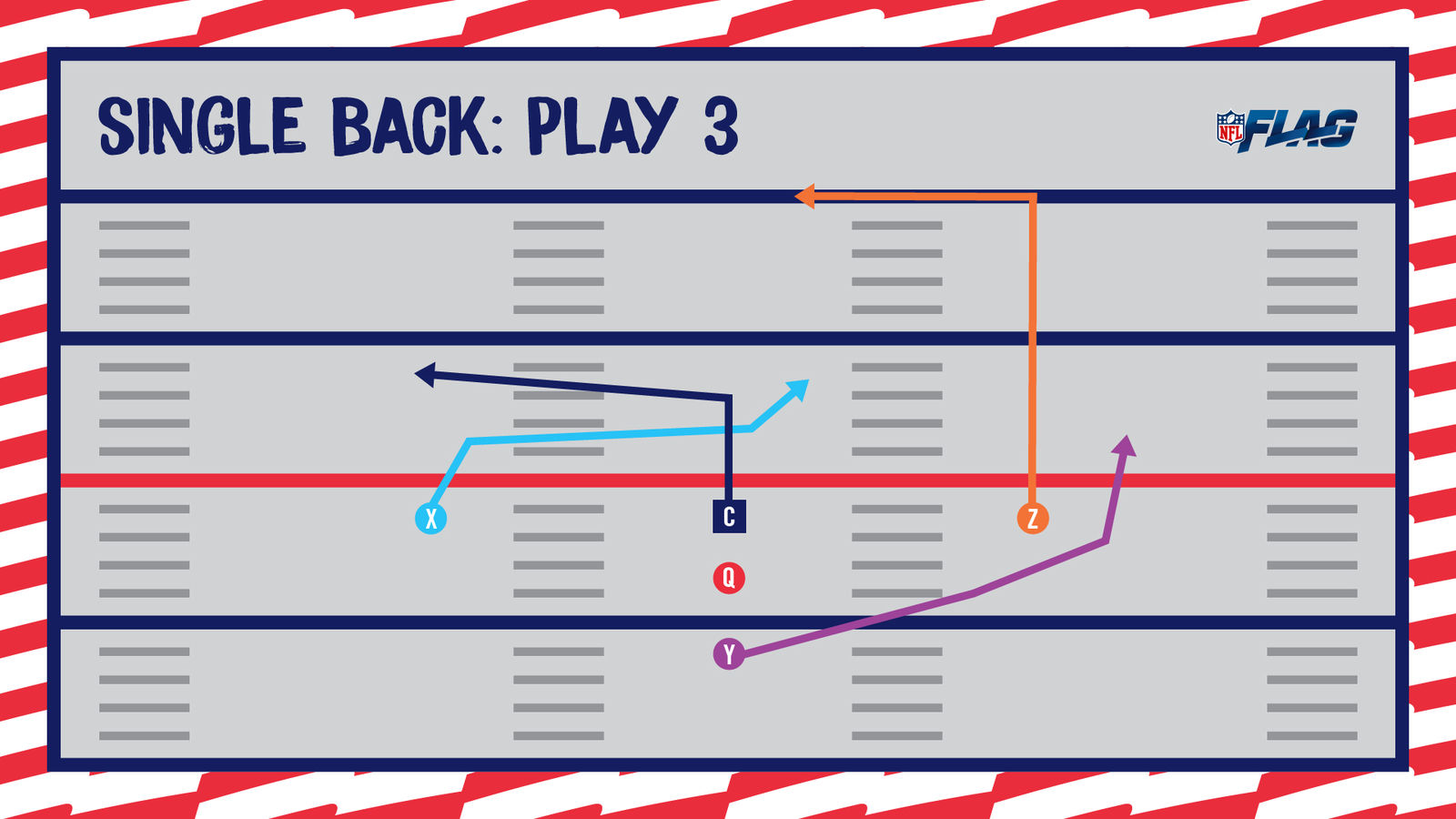
Spread Formation
In the spread formation, all three receivers are essentially on the line of scrimmage—with one starting a couple yards behind—allowing for a slight delay in routes that will catch defenders off-guard.
Pro-tip: While this image shows one recommended spread of the receivers, any of these football plays can be adapted to have receivers in different locations. And these flag football plays 5 on 5 can be altered for 7 on 7. Personalize the plays to make them your own!
Is your opponent’s defense a little weaker on the right? Then we’ve got the perfect 5 on 5 flag football play for you.
On hike, Receiver Z does a juke around their defenseman and a fly route for some long yardage. Receiver Y then does an option route toward the right sideline. This player will find themselves in the empty spot from the far receiver pushing the defense back. The center also pushes toward the right sideline for further options.
Have all the defensemen now shifted right? No worries, use Receiver X for a post route for some great yardage.
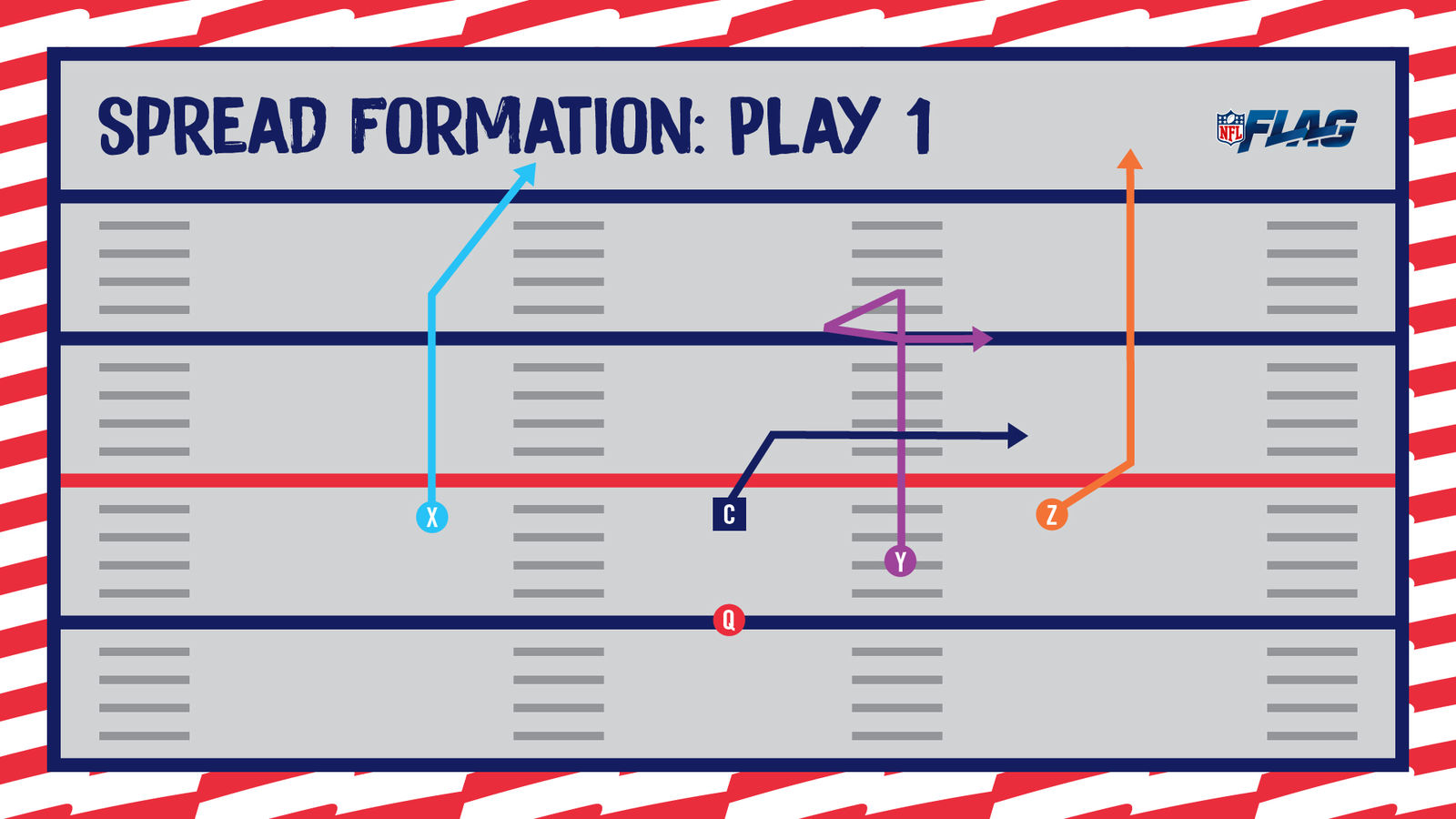
Or maybe the defense is weaker on the left? We have a football play for that too!
Receiver X does a quick option route toward the left sideline, pulling the defensive line far left. This allows Receiver Y and Z to do in and post routes respectively for long yardage.
If the defense has now all shifted to the left, the center can then release for an out route toward the right sideline for some quick yardage.
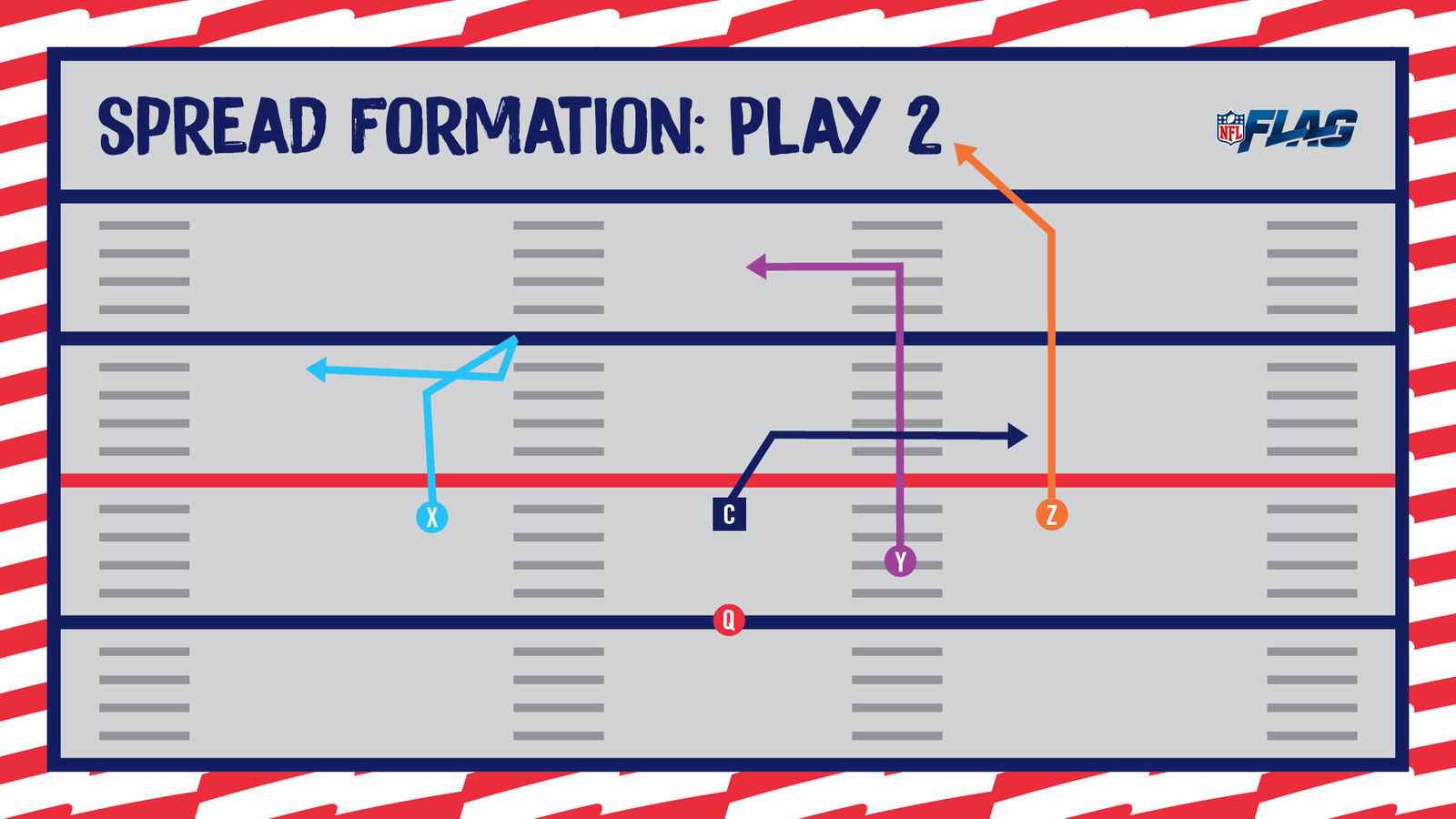
Using routes with crossing players is always a good strategy. For this football play, Receiver Y does a five yard out play, crossing the far right receiver who does a hitch play. Receiver X and center also cross as they both do slants—the defense won’t know what hit them.
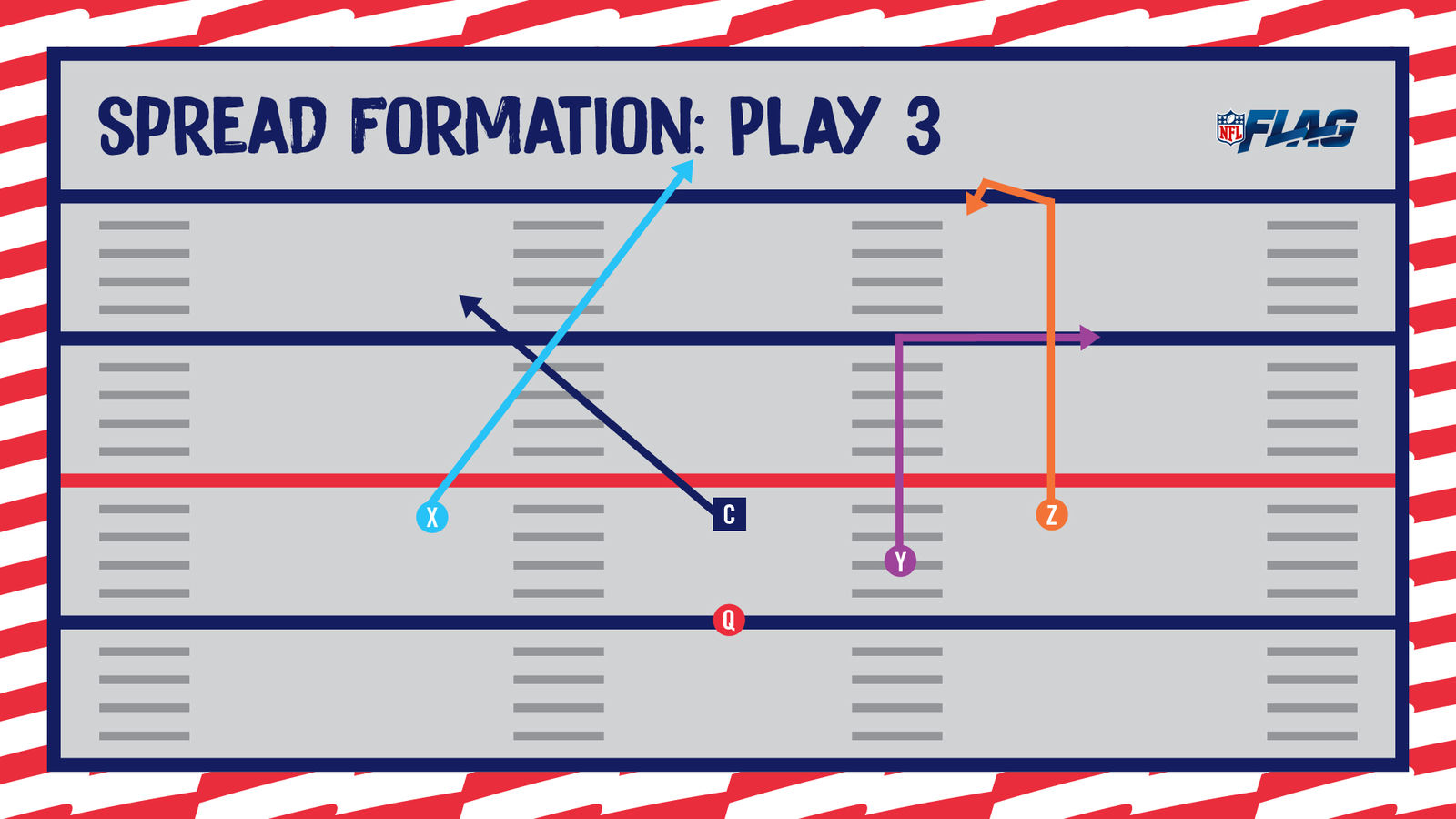
Bunch Formation
For bunch plays in 5 on 5 flag football, your offensive line starts close together and then spreads out to their respective location. This is to clump the defense, so they’re ill-prepared to move quickly upon hike.
Due to the difficulty of this football play, we recommended setting an order on who moves first to avoid collisions or hesitation.
First, the center and Receiver Y do respective corner routes, thus drawing the defense scrambling back. From there, the other two receivers do staggered out plays of shorter distance. This way, receivers are open both for short and long yardage.
Make sure to practice this 5 on 5 flag football play ahead of time, before adding it to your football playbook, since it’s a bit more advanced.
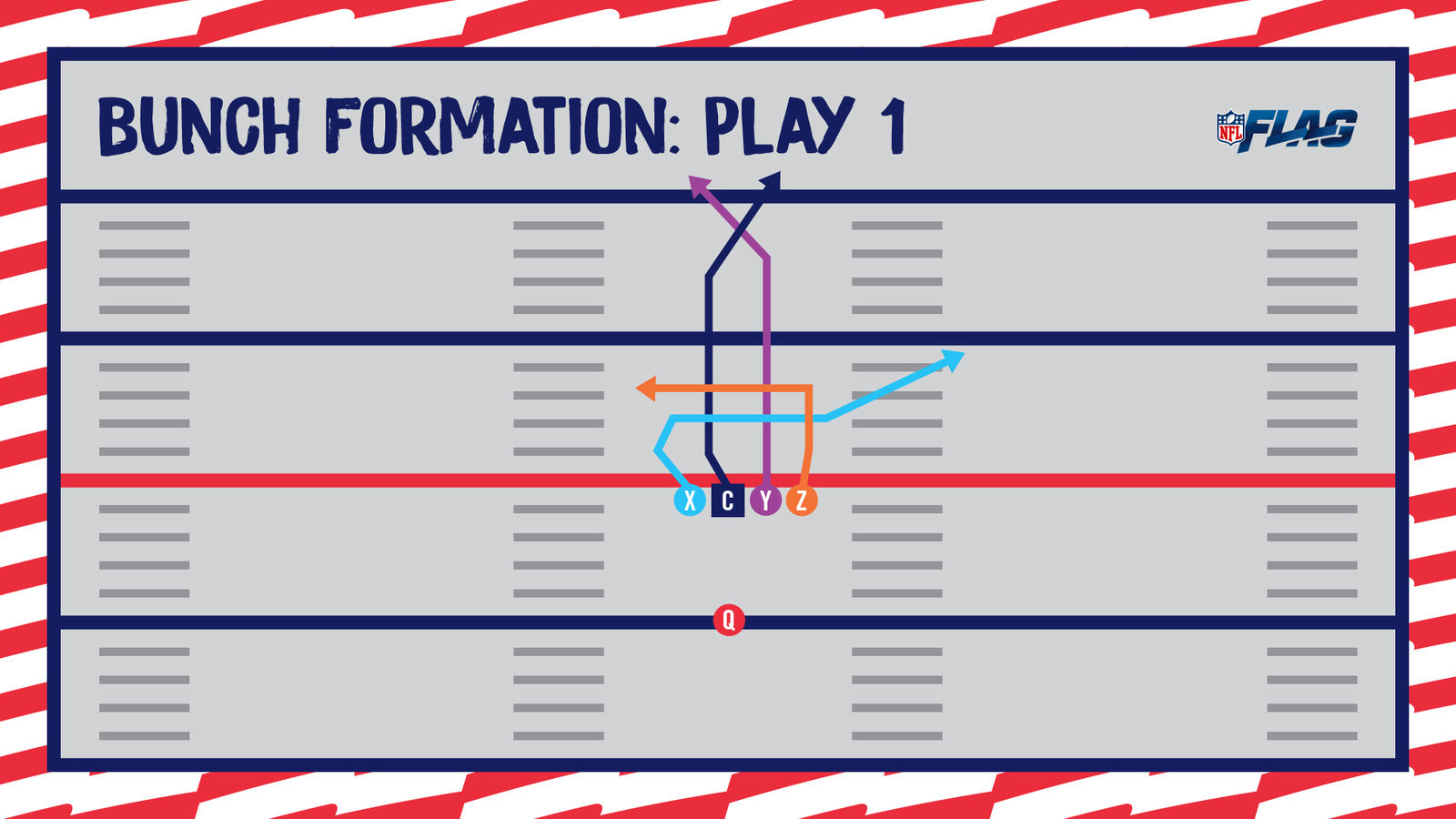
This flag football play is a less complicated version of the play above. Upon hike, Receiver X and Receiver Z do corner routes, drawing the defensive line back and out.
Once the defensive line is drawn away, Receiver Y and the center do crossing out routes toward the five-yard line. These spaces should be open for some quick yardage.
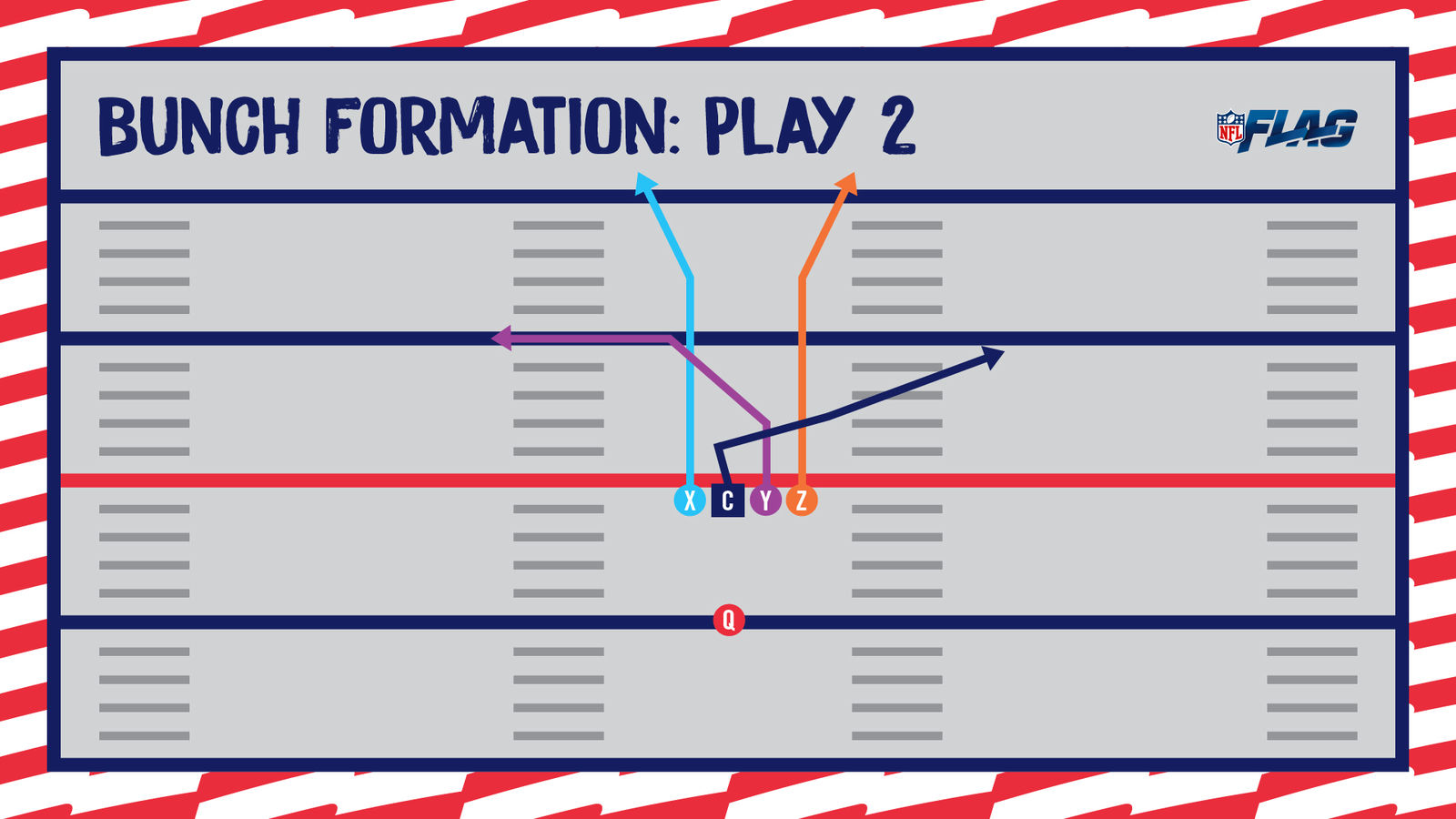
The main objective of this football play is to get the defensive line caught up with each other in the center, then spreading out to various points of the field for openings.
Receiver X and Receiver Y both do a seven-yard run, then a corner route. These are the recommended receivers if you need some long yardage. Receiver Z and the center do a five and out route, aiming for the sidelines. These spots should now be open for a quick catch, as the defense pushes backward to cover the first two players.
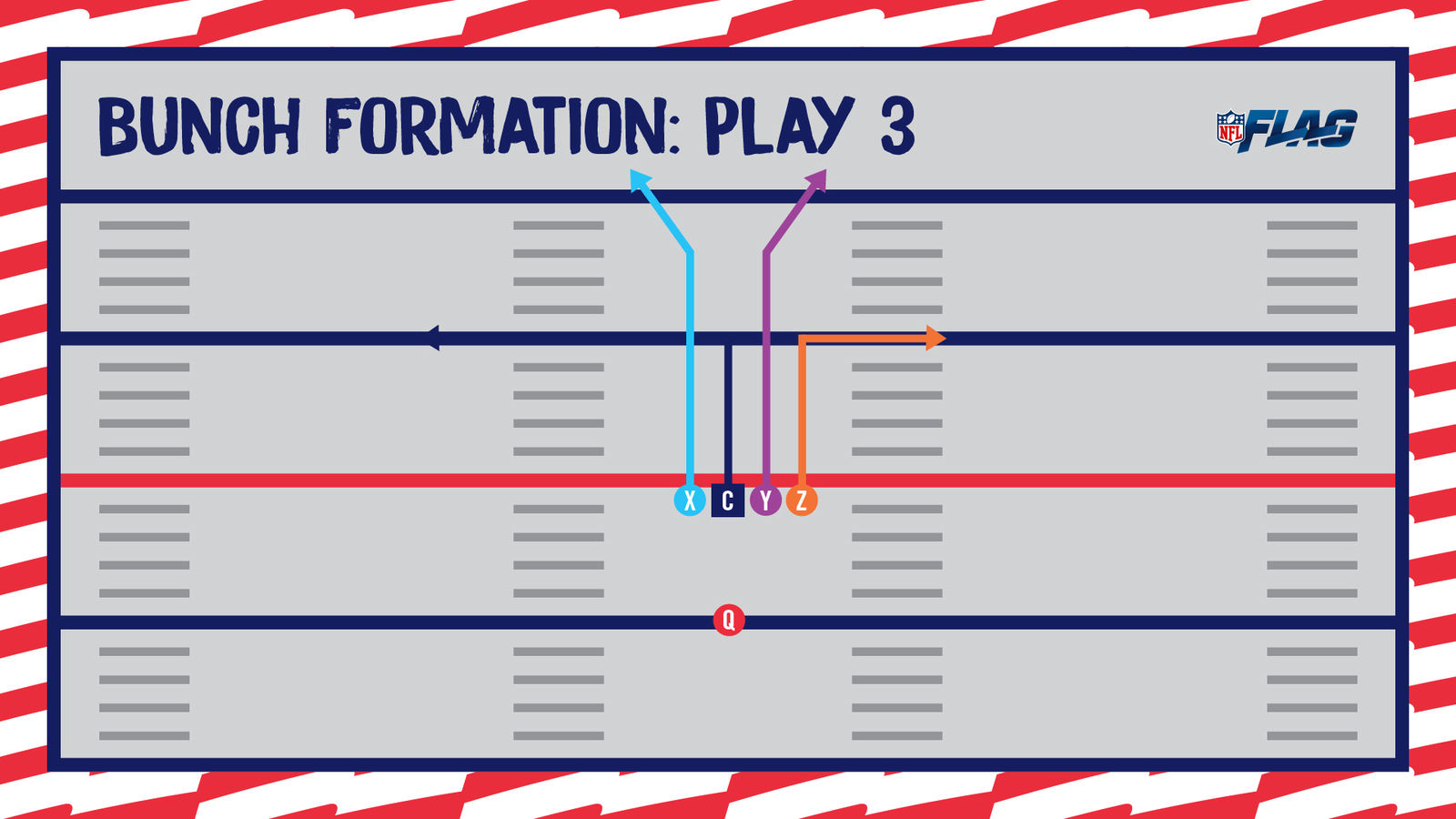
Trips Formation
During a trips formation, all three receivers are on one side of the quarterback at the start of the play. Note that while we’re demonstrating right trips for our plays, all the plays can be adapted for the left side.
For this flag football play, all receivers line up to the right of the quarterback on the line of scrimmage. At hike, Receiver X does an option route at five yards, cutting a little toward the sideline. Receiver Y does an angled out at the five-yard line, and Receiver Z does a fly route. Then the center releases and does an angled corner route. This positions the players at staggered yardage, for various lengths of throws.
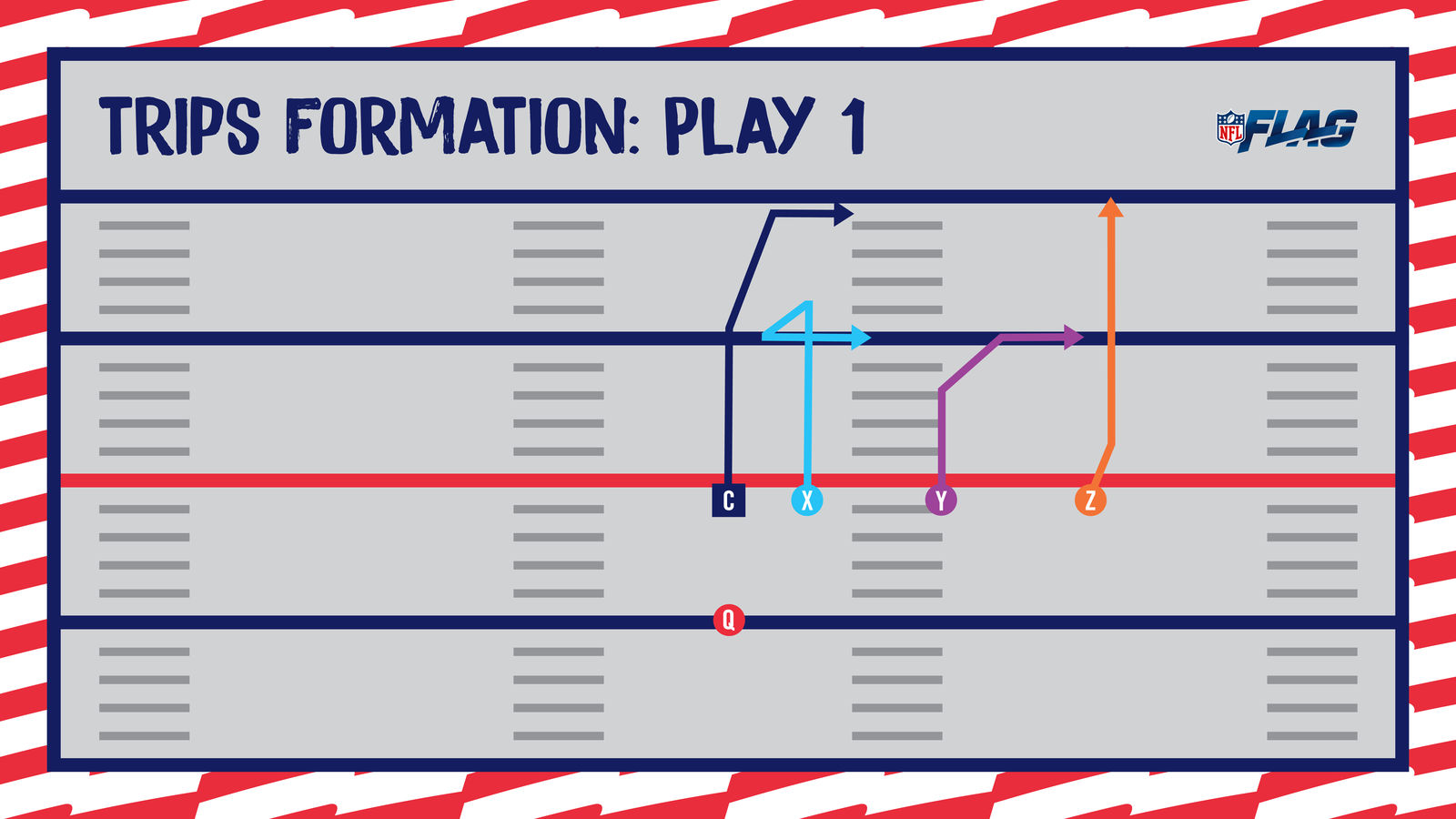
While this play also staggers the receivers at various lengths, it contains a cross to catch the defense off-guard as they focus on the right side of the field.
At hike, Receiver Z does a fly route, and Receiver Y does a corner route at seven yards. Meanwhile, Receiver X and the center do out and in routes, respectively. This should open up the inside receiver on the left side of the field, since the defense will be pulled to cover the receivers doing heavy yardage on the right.

This flag football play also takes advantage of the defense being on one side of the field, but in a slightly trickier way. That’s why it’s one of our favorite 5 on 5 flag football trick plays and a must-have in your youth football playbook.
After hiking the ball, Receiver Z does a hitch route around the nine-yard line, where Receiver Y does a long corner. This opens up two receivers at long yardage if you need a first down. Then Receiver X does a quick option route at around the five-yard line. This tricks the defense into thinking the player is going left, while they’re actually going right. The defense should eventually follow the player to the right, leaving the center wide open for an out route at the five-yard line.
Pro-tip: Have the center wait a couple seconds before running their route. This will allow the receivers to draw the defense to one side, leaving the other side wide open. You’ll thank us later.
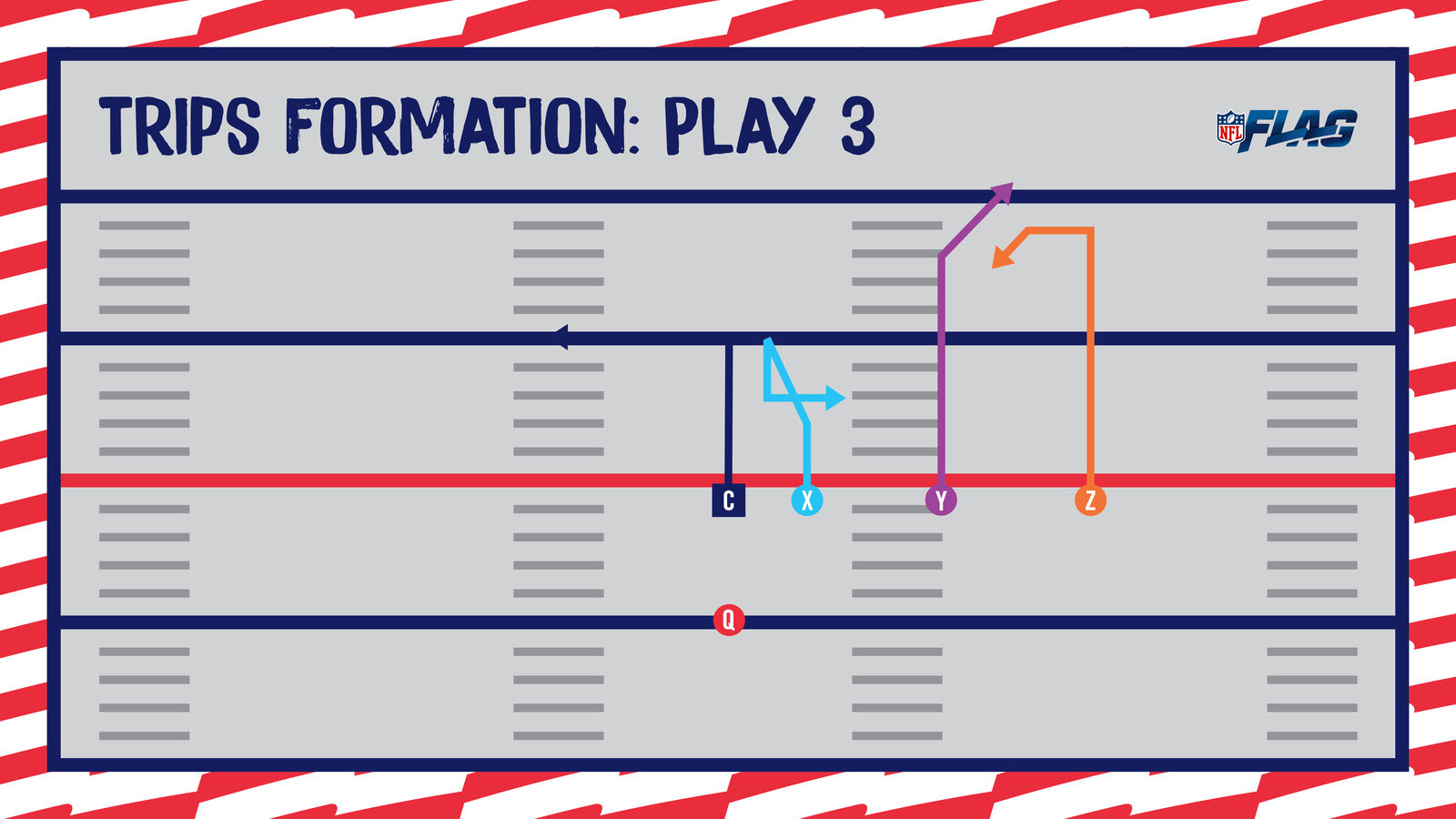
Twins Formation
For the twins formation for 5 on 5 flag football plays, think of the non-quarterbacks as two pairs, or twins. These two sets of twins stand close to each other at the beginning of the formation and compliment each other.
At hike, the two receivers on the right run angled post routes, at staggered lengths, which should draw the defensive line toward the center.
At this point, Receiver X and the center do quick in and out routes, respectively. These routes should both be at low yardage, so prepare for a quick pass. This route is perfect for closing a small gap for a first down.
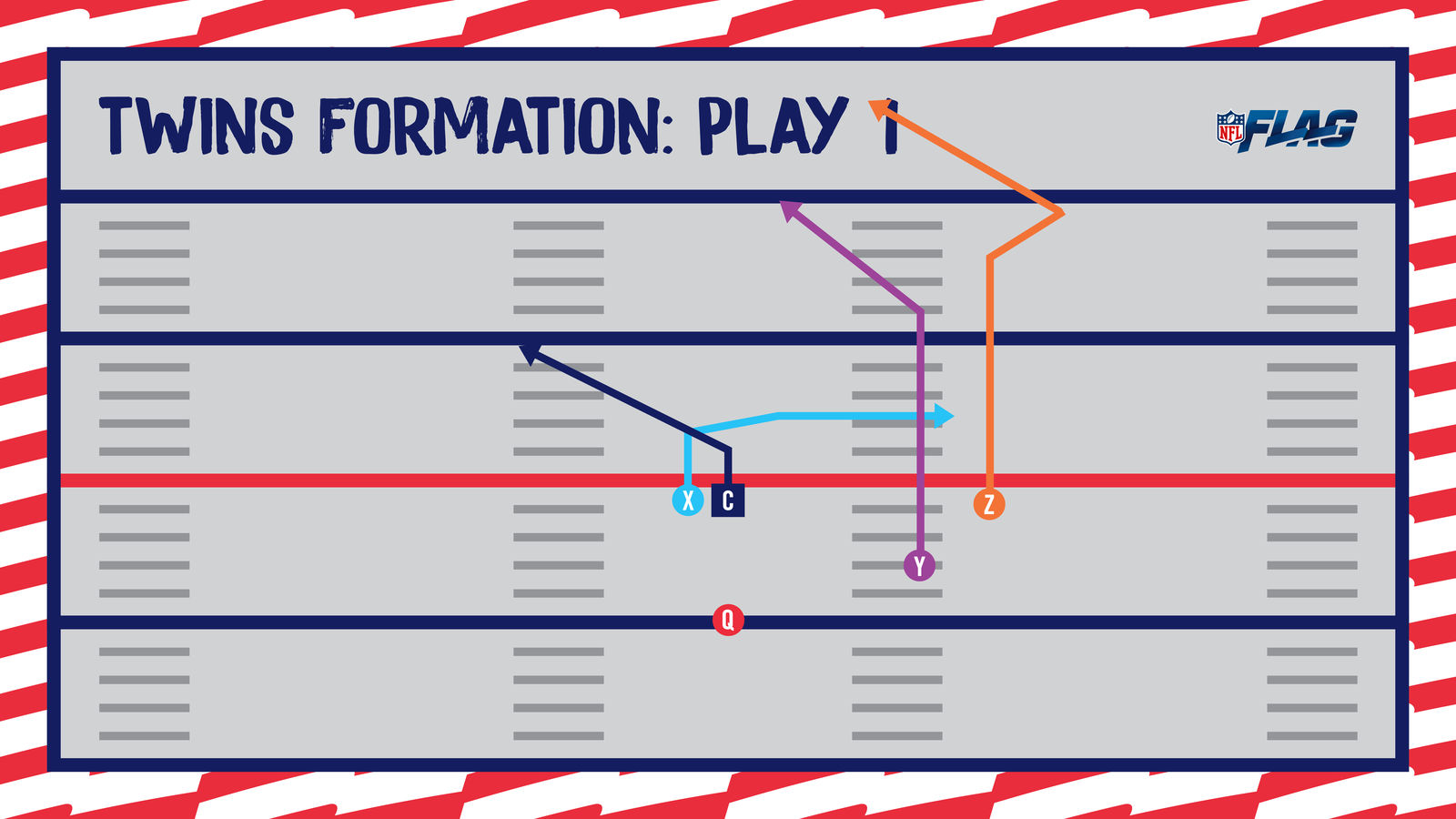
At hike, Receiver Z runs a fly, where Receiver Y runs a five and out. Meanwhile, Receiver X does a slant into a fly. These three routes should draw away the defense from the middle, allowing for a quick throw to the center during an option route.
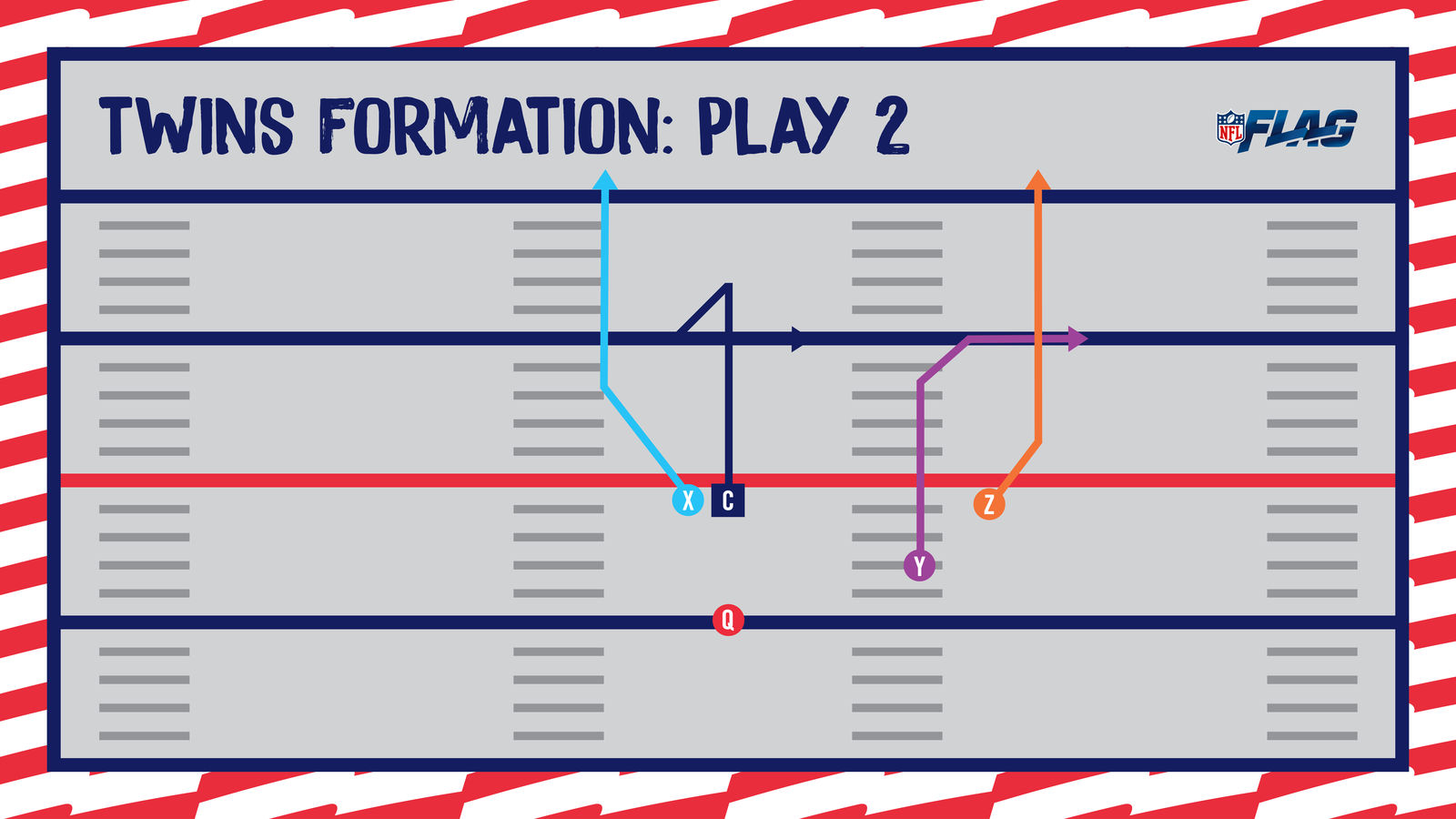
For this football play, after the quarterback calls hike, Receiver Z receiver does a post route and Receiver Y does a chair route. Meanwhile, Receiver X runs a corner and the safety releases into a five an out. The chair route is especially effective, as there are two changes in direction, opposed to the usual one.
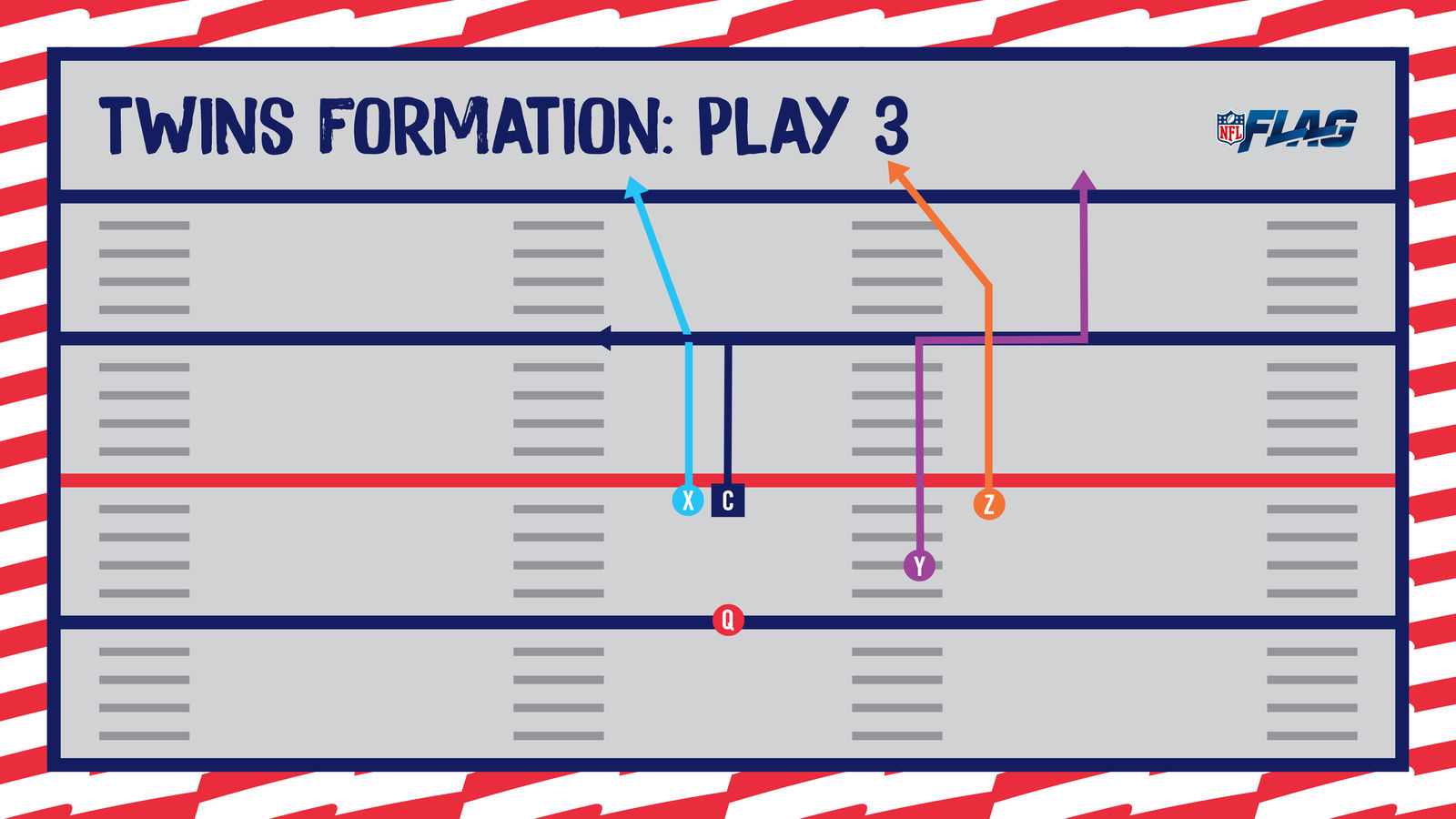
I Formation
In the I formation, all three of the receivers are stacked behind the quarterback. This can be a good formation as it doesn’t give any indication to the defense on where the offensive players plan to go. These offensive football plays are sure to leave the defense scrambling, making them a great addition to your flag football playbook.
At hike, Receiver X does an angled out route, after they hit the line of scrimmage. Receiver Y does an angled fly, and Receiver Z does a quick hitch route after crossing the line. Additionally, the center releases and does a corner route. This flag football play should draw the defense in all directions, leaving the middle particularly vulnerable.

After the hike, Receiver X does an angled out route, as does Receiver Y. Receiver Z does an angled hitch route at around the five-yard line. The center should release and do a corner route.
Pro-tip: When using this football play, have Receiver Z stall their route a few seconds. This allows the other receivers and center to draw the defense away from the middle, leaving the hitch route less protected.
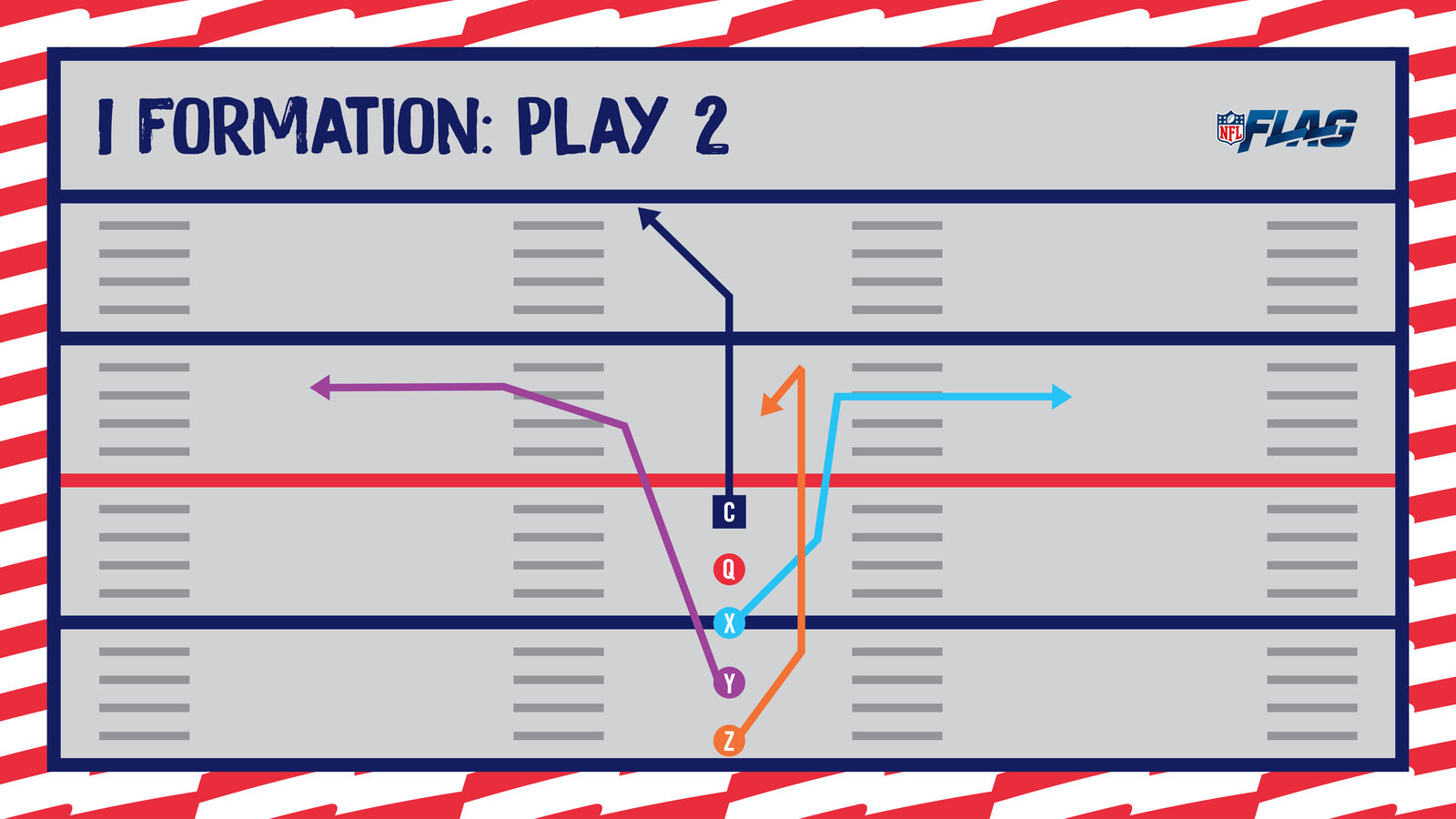
For this flag football play, Receiver X does a chair route at shallow yardage. Receiver Y then crosses Receiver X at a five and out. Receiver Z runs two slants and the center releases and runs a fly, opening up the play to some heavy yardage.
Safety pro-tip: Since Receiver X and Y cross paths twice in this play, make sure they discuss who runs first, so they don’t bump into each other. Additionally, before you add this one to your flag football playbook, we recommended that you practice this route ahead of time to decrease likelihood of injury.
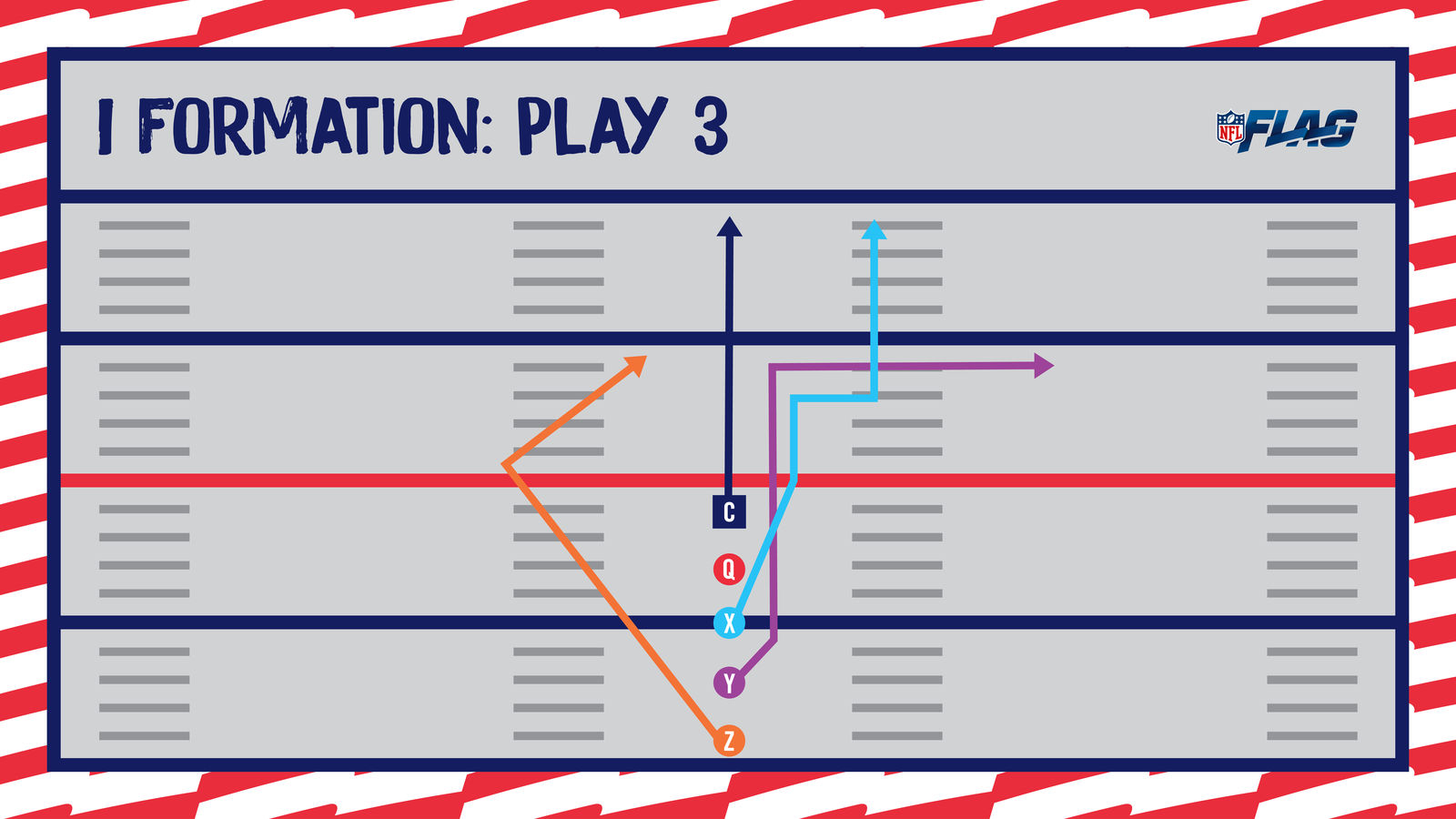
Double Back Set Formation
In the double back set formation for 5 on 5 flag football plays, two receivers stand on either side of the quarterback, a couple yards back. The last receiver stands farther from the quarterback at the line of scrimmage. These football plays demonstrate the final receiver starting on the right side, but they can be adapted for the left as well.
Upon hike, Receiver X does an out route at four yards, pushing toward the sideline. Receiver Z does a post route, and the center does a five and out. These routes should leave an opening in the center, perfect for Receiver Y to do a shallow hitch route.
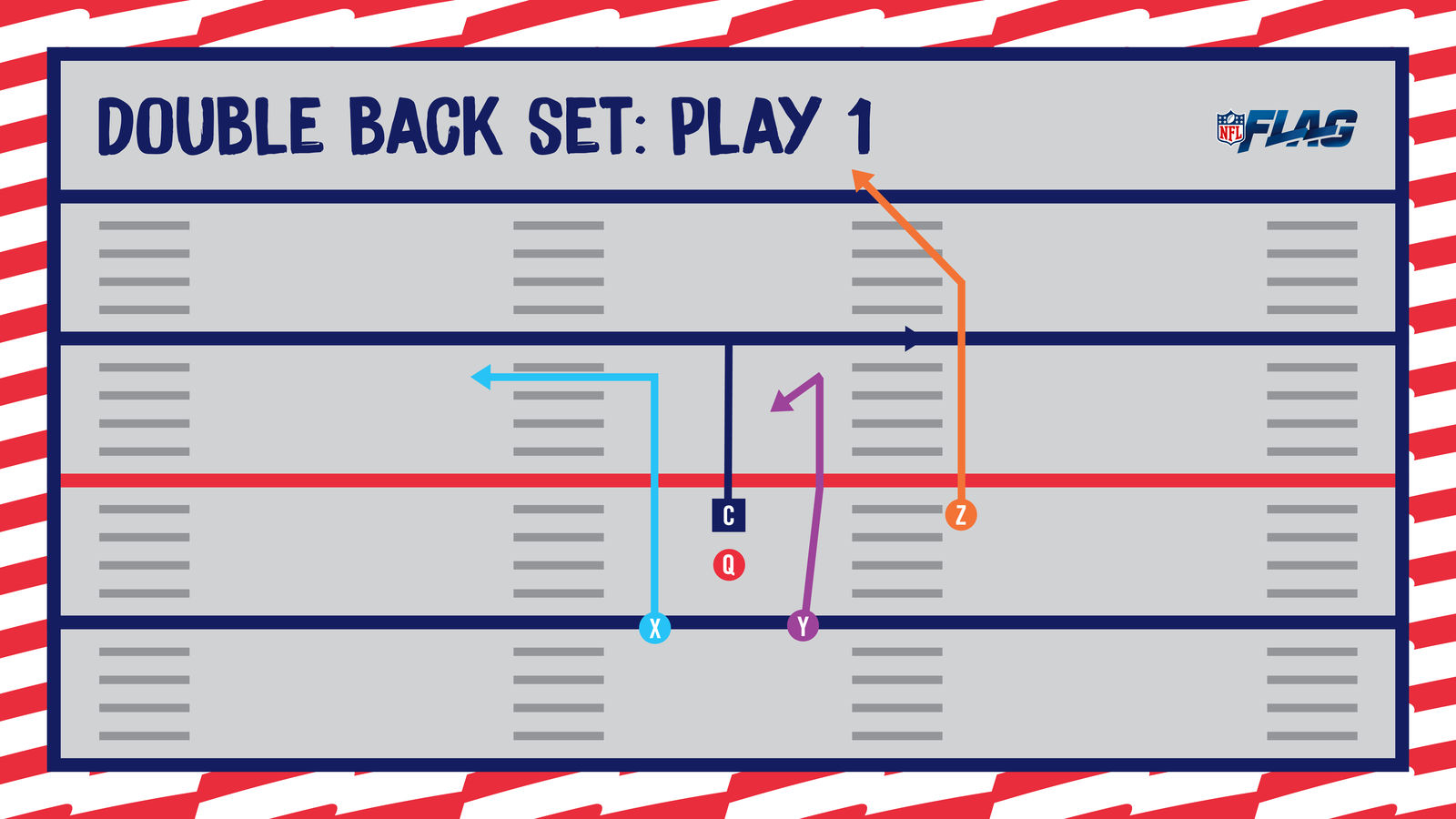
After the ball is hiked, Receiver X does a post route for deep yardage. Receiver Y does an angled chair route for an equally deep distance. These routes should draw the defense backward, leaving more opening up close. Receiver Z then does an angled in route, and the center does an angled out. These players are your recommended targets if you need short yardage for a first down.
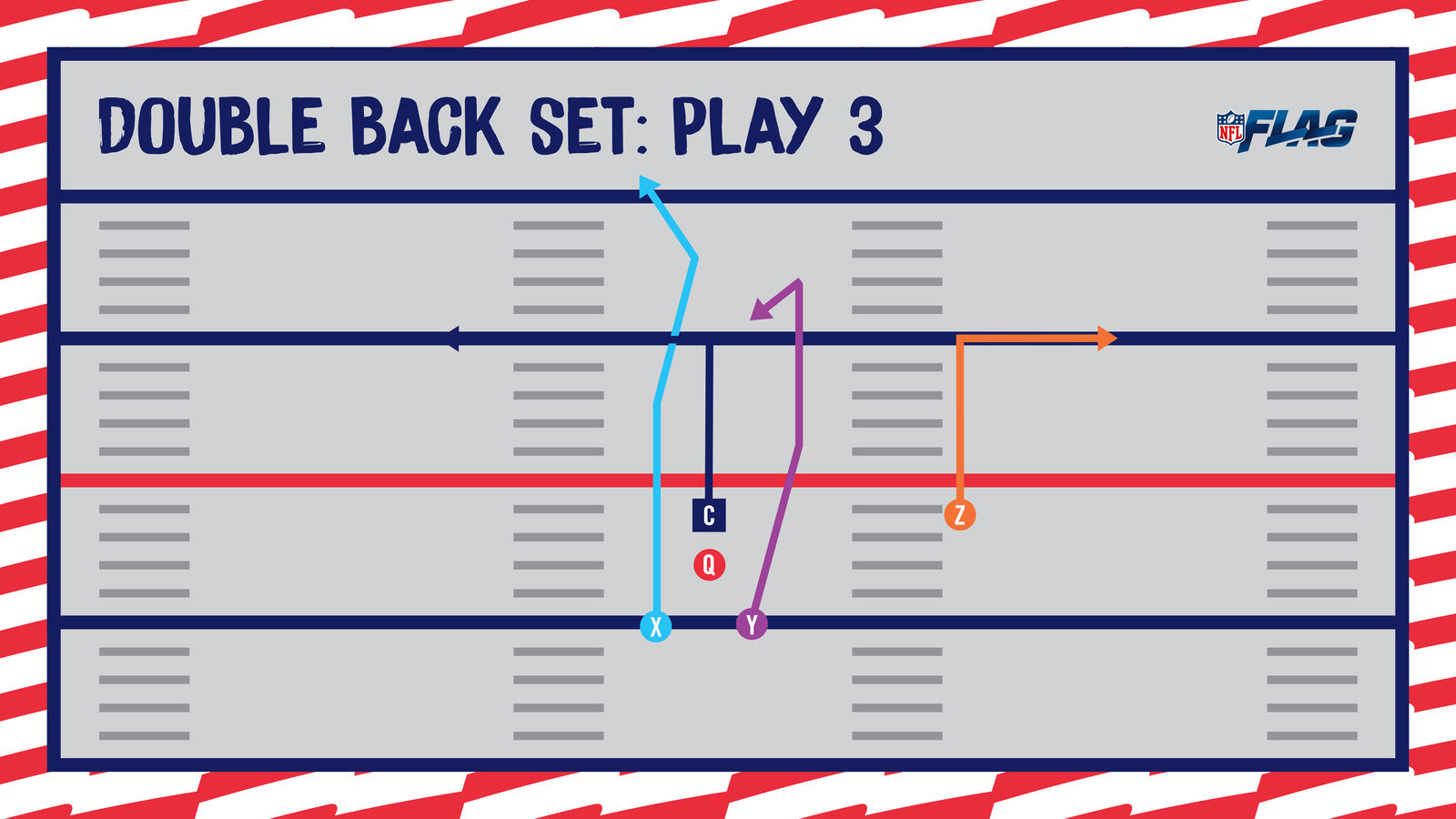
To start this flag football play, Receiver X does an angled corner route, and Receiver Z does a wide five out. Receiver Y does an angled hitch route, and the center can release for a five and out. This pushes all the players into different spots on the field, creating a variety of throwing options. It’s a great offensive football scheme to add to your youth flag football playbook.
Trips Stack Formation
For this formation, the three receivers stand on one side of the quarterback stacked vertically. During our football plays we demonstrate the trips being on the far right side, but the stack can be located anywhere you prefer along the line of scrimmage.
At hike, Receiver X runs eight yards, then does a corner route. Receiver Y does an angled post route, and Receiver Z does an angled fly. All three of these routes drives the defense deep in the field, allowing the center to do a quick five and out for short yardage.
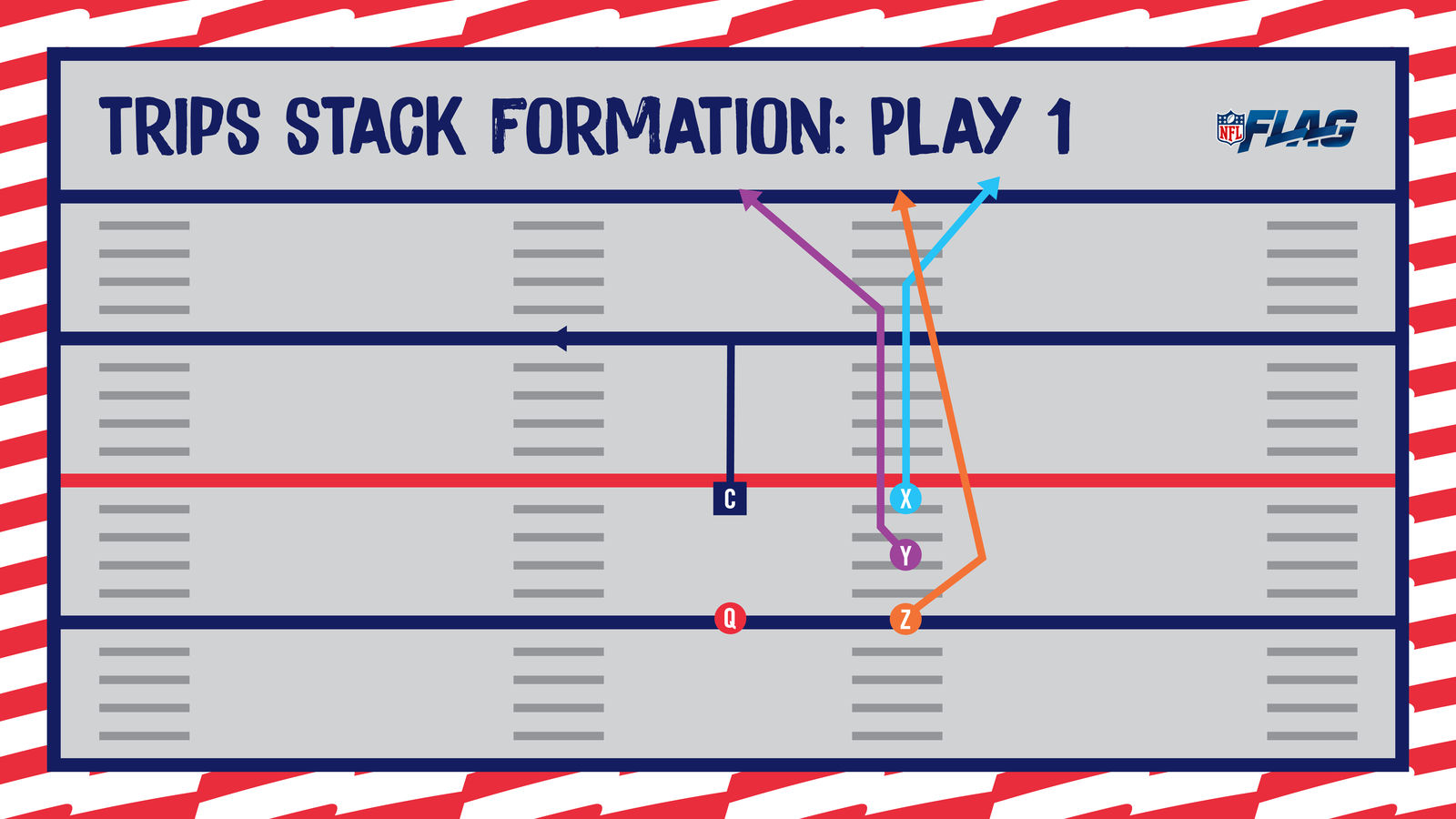
At hike, Receiver X does a short post route, and Receiver Y does a shallow out route aimed for the sideline. Receiver Z then does a hitch route at the 10-yard line, creating a deeper pass option. If none of the receivers are open, the center can release into a fly route for some heavy yardage.
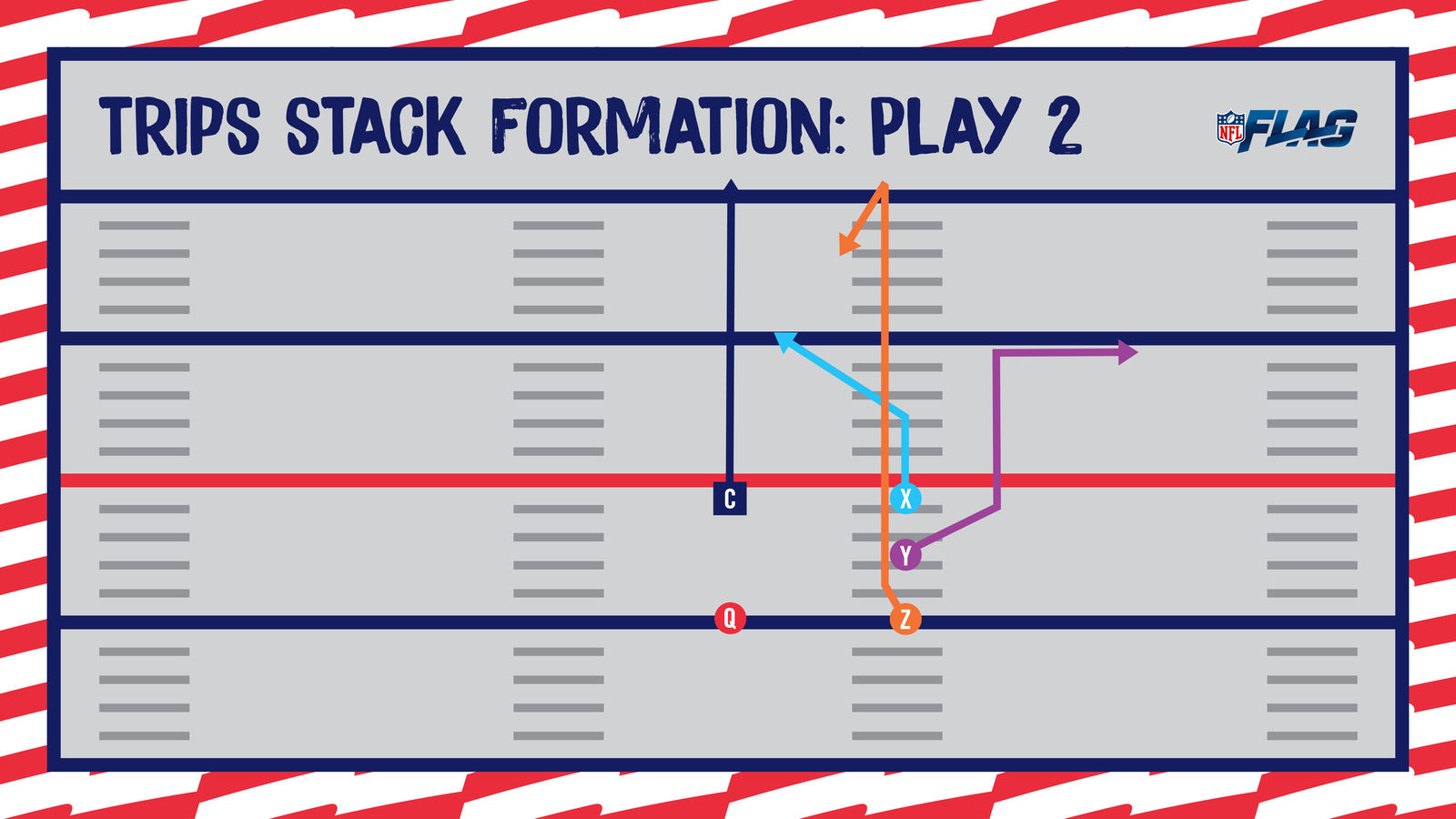
This flag football play focuses on the right side of the field, with two cuts toward the center, and is a perfect strategy to use against a team with a weaker right defensive side. Upon hike, Receiver X does a seven yard run, then cuts in. Then Receiver Y does an angled corner route, with Receiver Z doing an angled in route. The center does a deep corner route, further playing into the right side’s weakness.
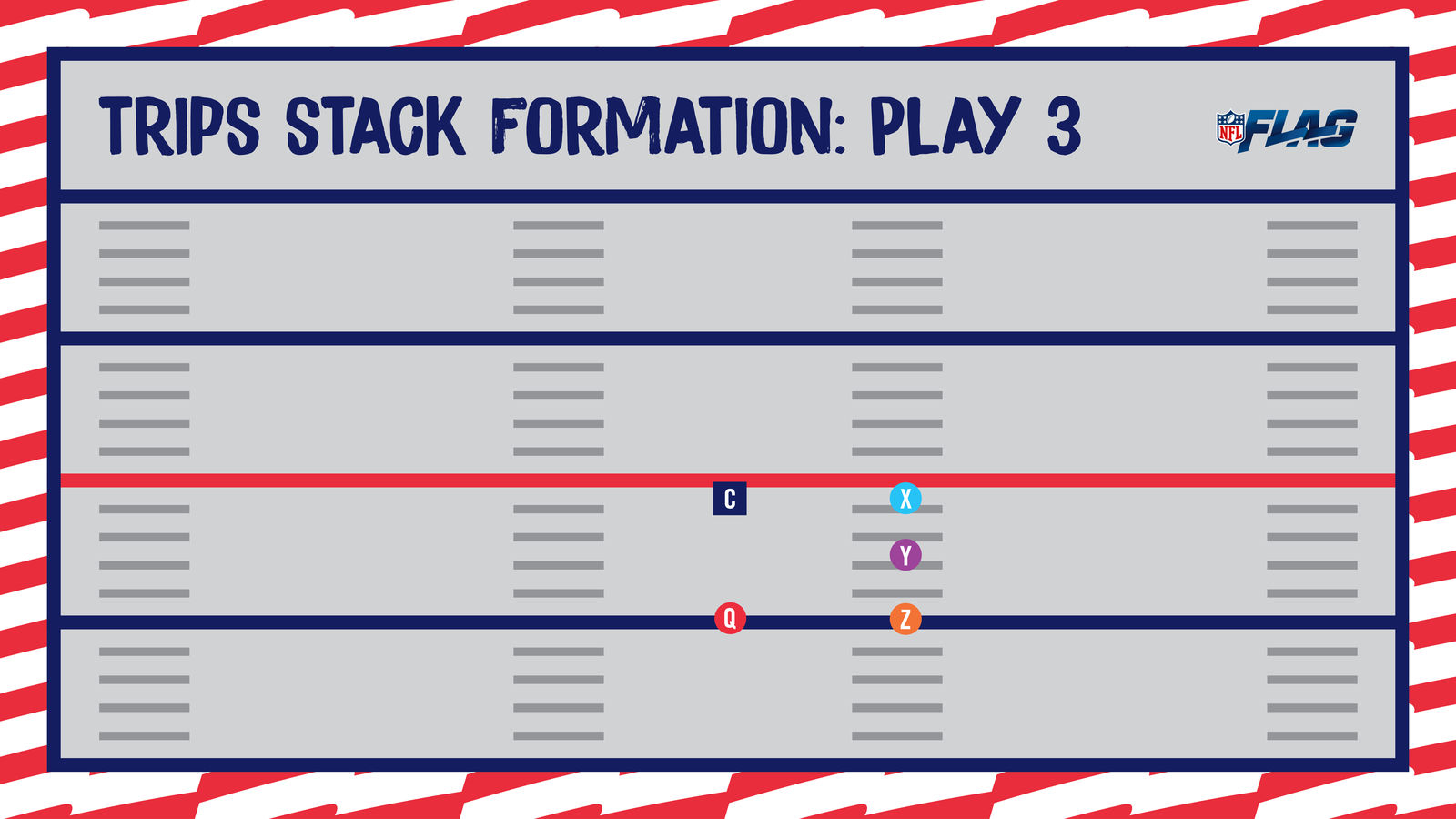
Twins Stack Formation
You’ll find that the twins stack formation is very similar to the trips stack. Two receivers stack on either side of the quarterback. In our offensive formations, we have them stacked on the right side, with the final receiver on the opposite side of the quarterback.
After hike, Receiver Y does a fly route, and Receiver Z does a five and out. Meanwhile, Receiver X does a fly and the center runs a five and out. This football play provides two options for short yardage, and two options for long yardage, so you’re covered regardless of the length of yards you need.
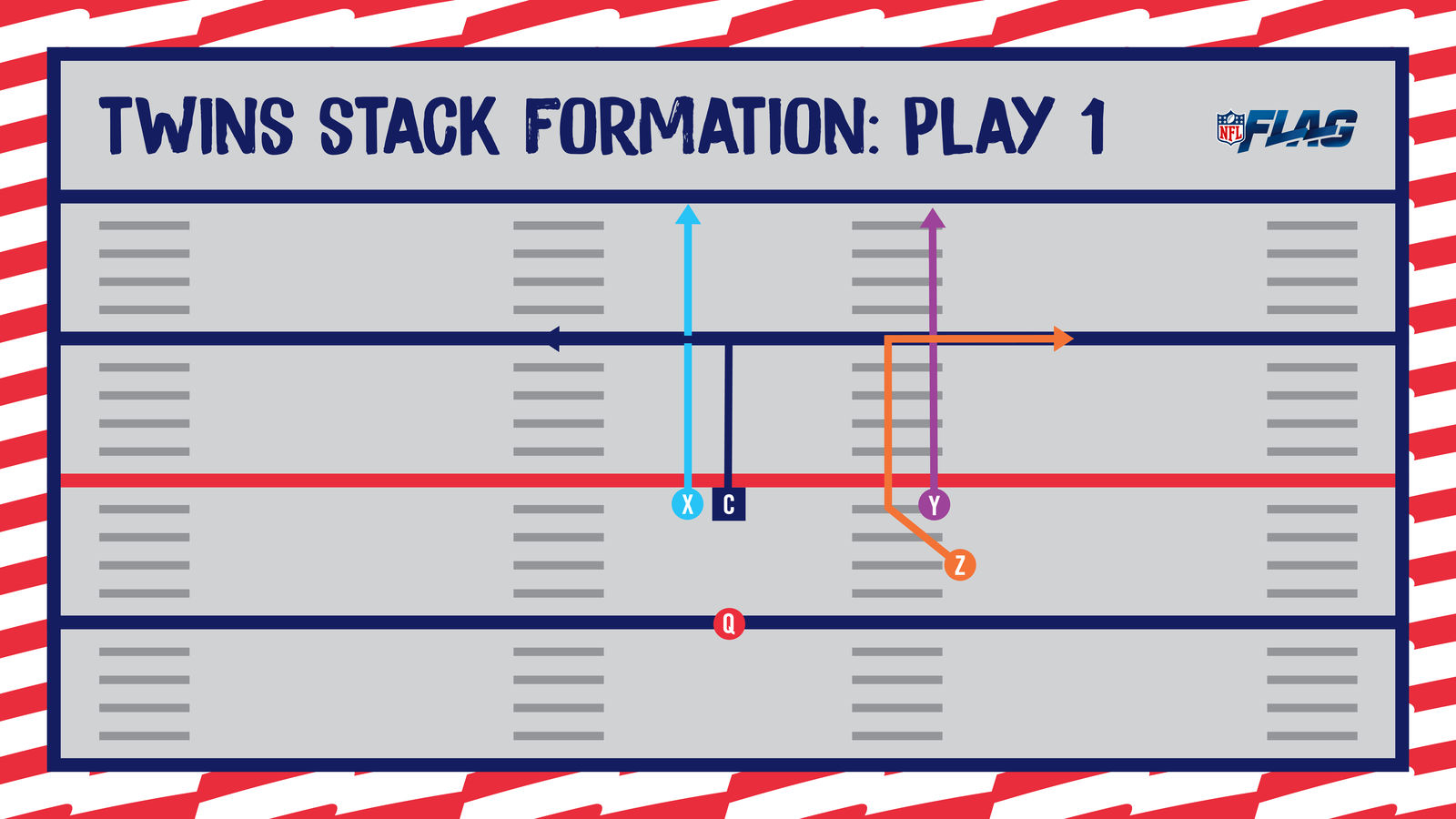
After the quarterback calls hike, Receiver Y does a seven yard corner play, and Receiver Z does a fly route. Meanwhile, Receiver X does a shallow post route, crossing the center who does a seven yard out route. This flag football play staggers out the yardage for each player, for various length options—another great beginner play for the football playbook.
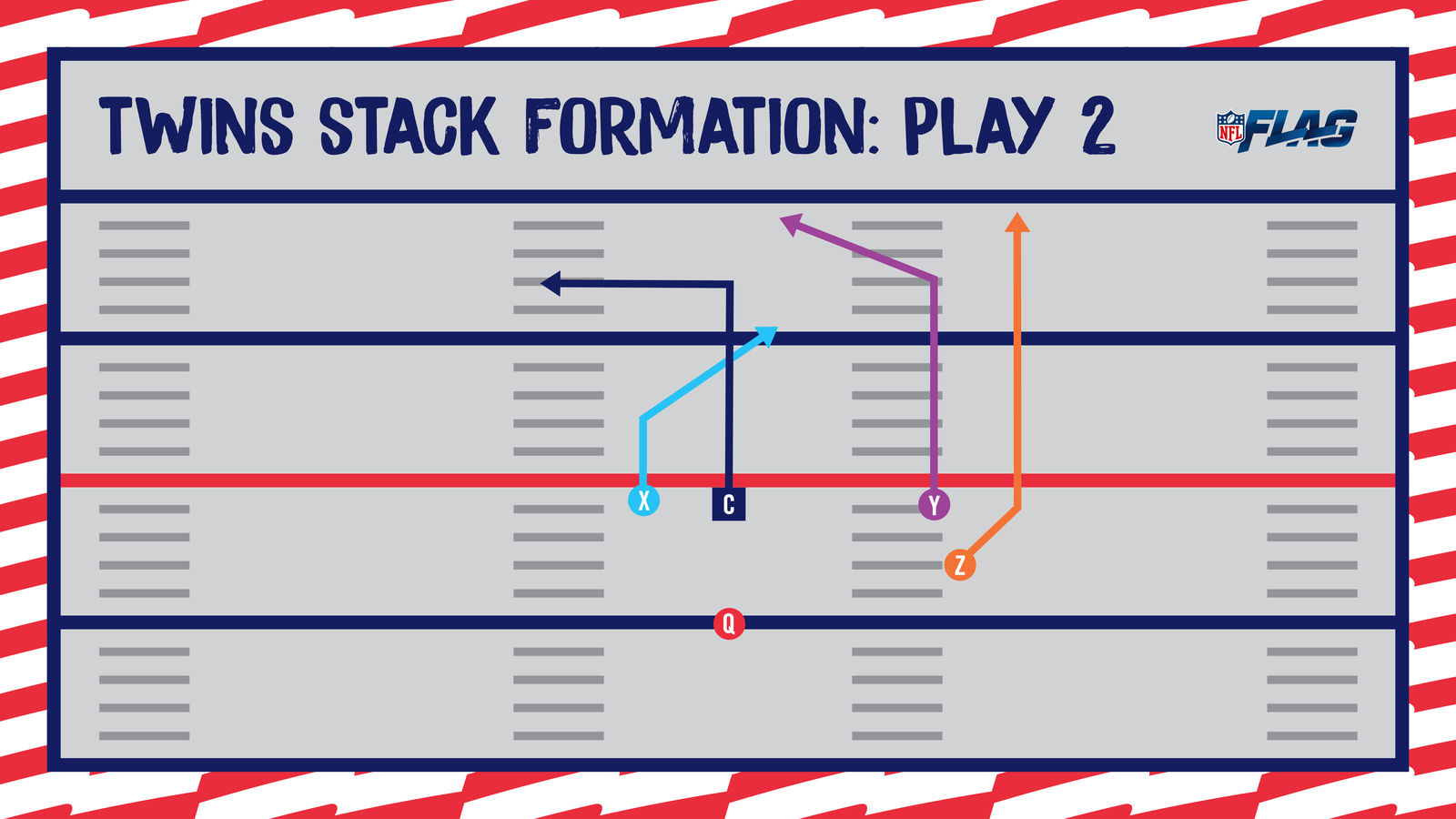
For this flag football play, Receiver Y runs an eight yard in route, while Receiver Z does a deep post route. Both of these routes are deep for heavy yardage. Meanwhile, Receiver X does a shallow option route across the center, while the center releases for a five and out. These two players will be open for more shallow yardage.
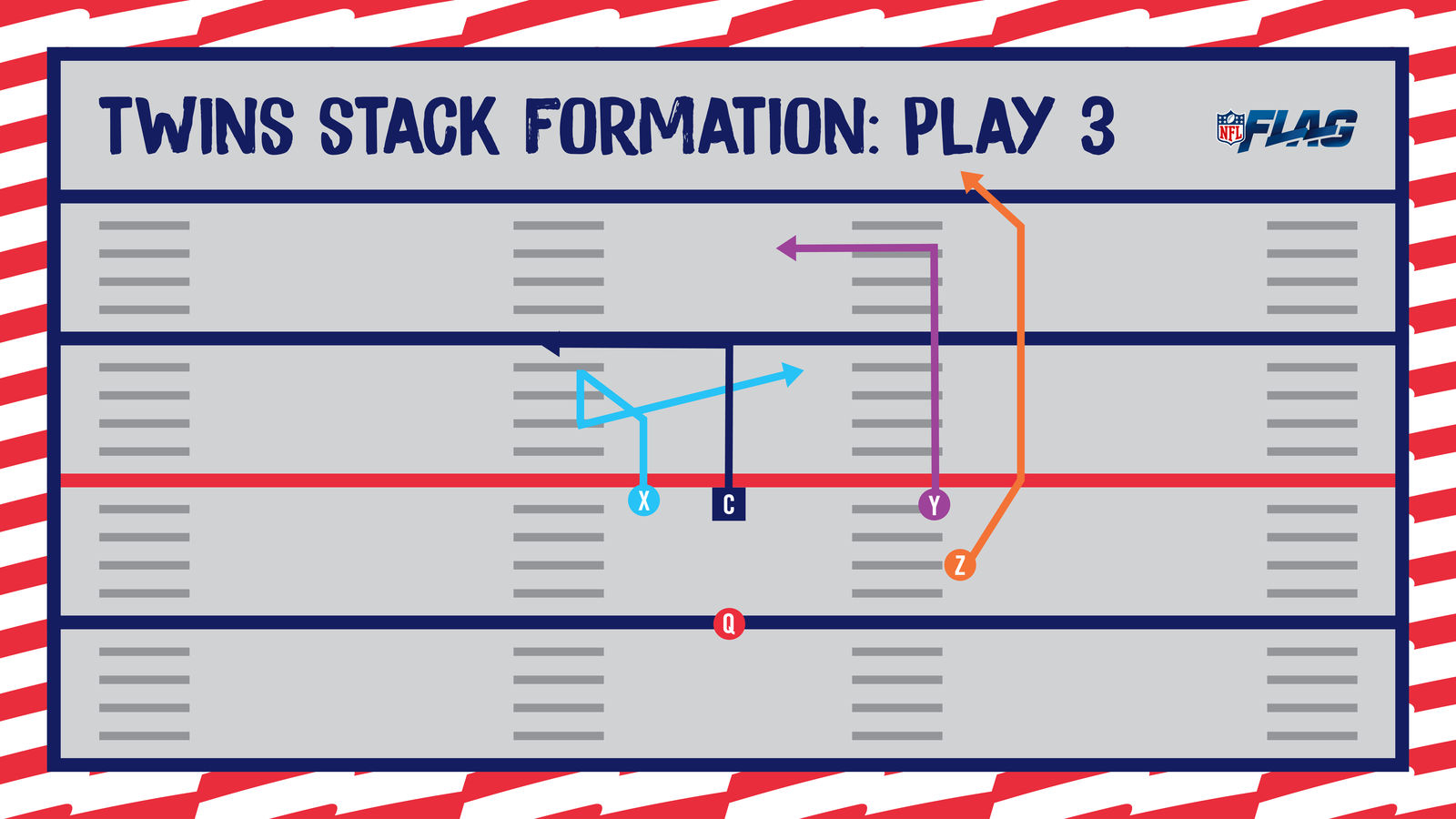
Single Set Formation
In a 5 on 5 flag football single set formation, two receivers line up on the line of scrimmage, equal distances away from each other. The final receiver stands a few yards behind the quarterback. Keep in mind that distance between players can be adjusted for personal customization.
Need some deep yardage to snag that first down? This might be the perfect beginner 5 on 5 flag football play for you. Receiver Y does a deep corner route, while Receiver Z does an angled fly route after juking their defenseman. This should pull the defense deep and to the right. Meanwhile, Receiver X does an angled fly route to the left. If short yardage is more in the cards, the center can release for a five and out route.
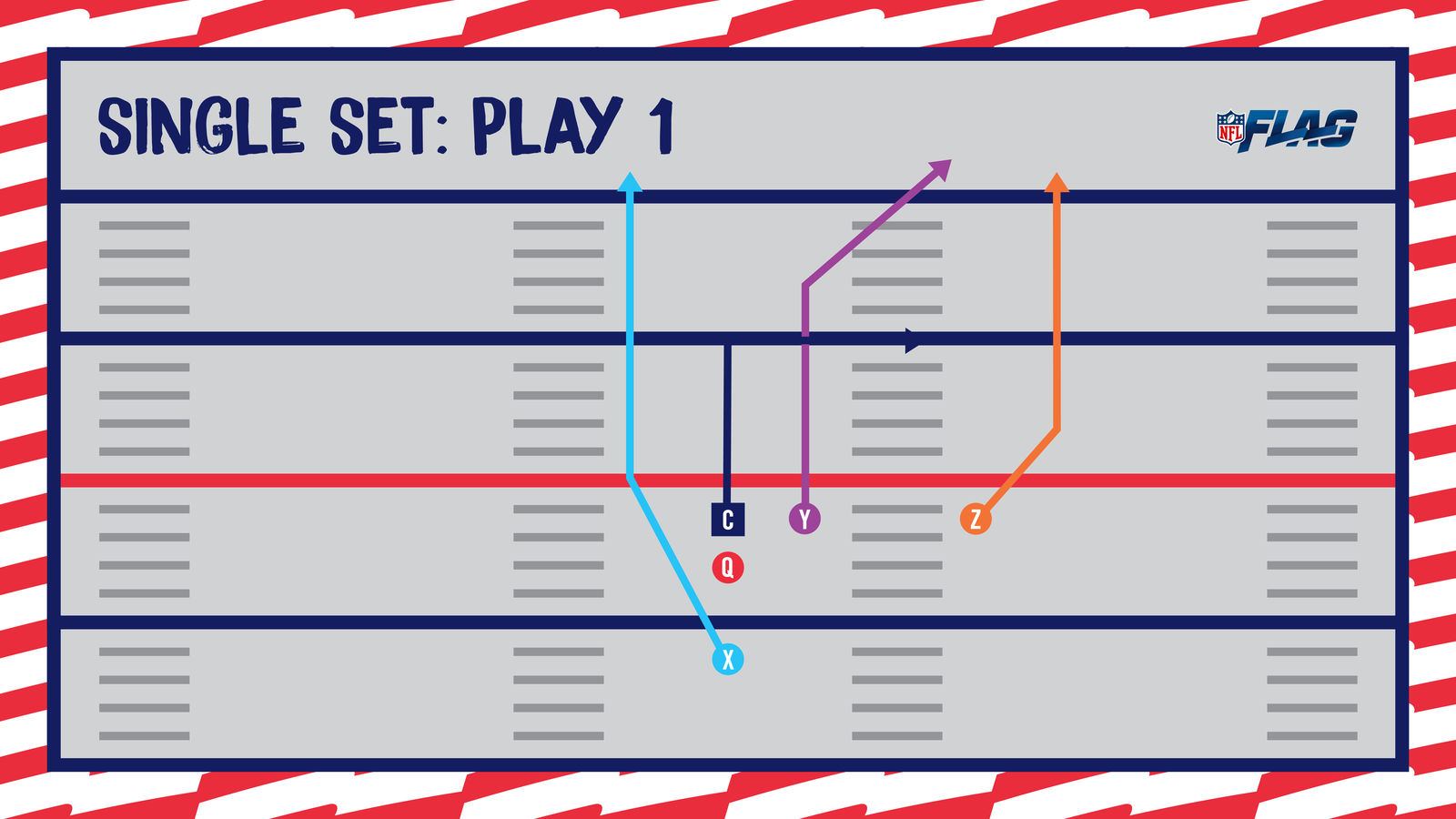
This flag football play has all four players at various lengths of yardage on the field, allowing for versatility from the quarterback. Receiver Z runs the farthest with a fly route. Receiver Y does a five and out, while Receiver X starts with a slant, before crossing across the middle in an out route. Lastly, the center can run a mid-length corner route.
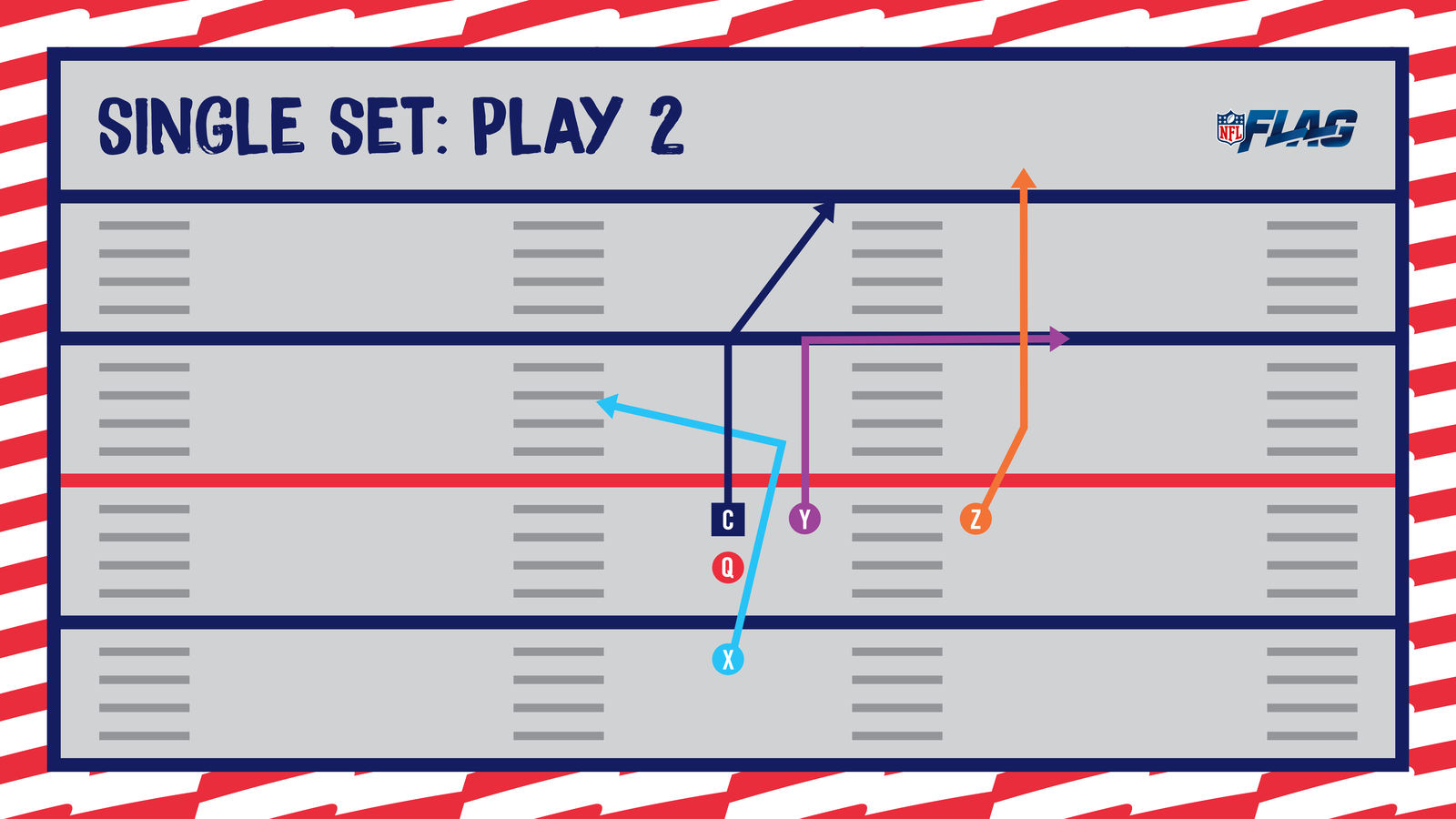
Upon hike, Receiver Z runs a post route, meanwhile Receiver Y runs a corner route, both at deep yardage. Receiver X runs an angled fly route, opening up the shallow left side, where the center runs a five and out.
Safety pro-tip: Whenever players are set to cross in their routes in youth flag football plays, practice the plays ahead of time. It eliminates any hesitation players may have on the field, decreasing risk of injury. After all, every second counts during a 5 on 5 flag football game.
